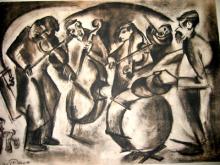Jewish culture has always had strong ties to music. One of the more iconic examples of Jewish music is klezmer, a boisterous style that emerged in Eastern Europe between the 17th and 19th centuries, eventually landing in America where it had a significant impact on 20th century pop music. Like the Jewish people themselves, klezmer is storied and well traveled. It has the cultural markers of many different societies mixed with concepts and sentiments endemic to Judaism.
The seeds of klezmer began in the ancient tradition of Jewish liturgical music. The chanting of passages from the Torah since the time of the First Temple has involved special intonation or "tropes" that add an expressive, sonic component to the recitation of scriptural stories. This eventually evolved into the tradition of the Khazan, the cantor who aids the rabbi during religious services by lending his or her powerful voice to the chanting of prayers. Jewish cantoral chanting attempts to convey the emotional tone of a story or prayer in the tones of the chant itself, even mimicking sounds of a human expression such as laughing and crying. This same method is also applied to the blowing of the Shofar, the instrumental ram's horn most often used during Rosh Hashana services. There is a ritual involving blowing the Shofar in a variety of ways that imitate the many emotions people experience throughout the year, from a breathy sort of laughter to a staccato crying sound.
In the early rabbinic age, music briefly ceased to be a part of religious observances but not Jewish life in general. The ancient principles of expressive, imitative musical sounds were incorporated into more secular, celebratory music like that which was played at wedding receptions. Before long, music as a profession became viable and minstrel-like bands began to form, especially in the region where modern-day Turkey and Eastern Europe meet. The term for these musicians was K'li Zemer, a Hebrew term that can be translated as "plucking thing", most likely referencing lyre-style instruments and then being a shorthand for musical instruments in general. Eventually the portmanteau "klezmer" became a term for instrumental musicians themselves.
Because the klezmer, like all minstrels, had a difficult time making enough money within the small communities from which they originated, they had to start traveling. They wandered throughout the hotly contested borders of the many competing empires of Russia, Europe and the Muslim world, picking up influences along the way. Without a doubt the most important influence on klezmer music is the musical tradition of the Roma, another nomadic people who traveled the region throughout the Middle Ages, Renaissance and early modern period. The klezmer combined the lively sounds of Roma instrumental arrangements with the traditional expressiveness of Jewish music to create songs that tended toward the extremes of human emotion, exuberant joy and maudlin sorrow.
Being on the fringes of society, the klezmer were often subject to restrictive laws, especially within cities. In the early 19th century there was a law in many Russian and Ukrainian towns that forbid the use of louder wind instruments in public. This forced the klezmer to change their instrument of choice from the clarinet (a natural evolution from the ancient instrument known as the aulos) to the quieter but still just as expressive violin. When those sound restrictions were lifted, klezmer re-integrated the clarinet alongside the violin to create the standard klezmer arrangement still seen today.
When Jews began immigrating to the United States in large numbers in the late 19th and early 20th centuries, they brought klezmer music with them. Around the time when American Jews started to more fully integrate into American society at the dawn of the 20th century, klezmer music began to disappear, or was rather absorbed by more pervasive cultural movements. Klezmer music was most certainly a component of jazz along with the devotional music of African Americans and the brass instrumentation of classical music from Western Europe. Enough traditional klezmer music was recorded in the 1920's and 1930's to provide a record of the style in a purer form, allowing for revivals over the next century.
